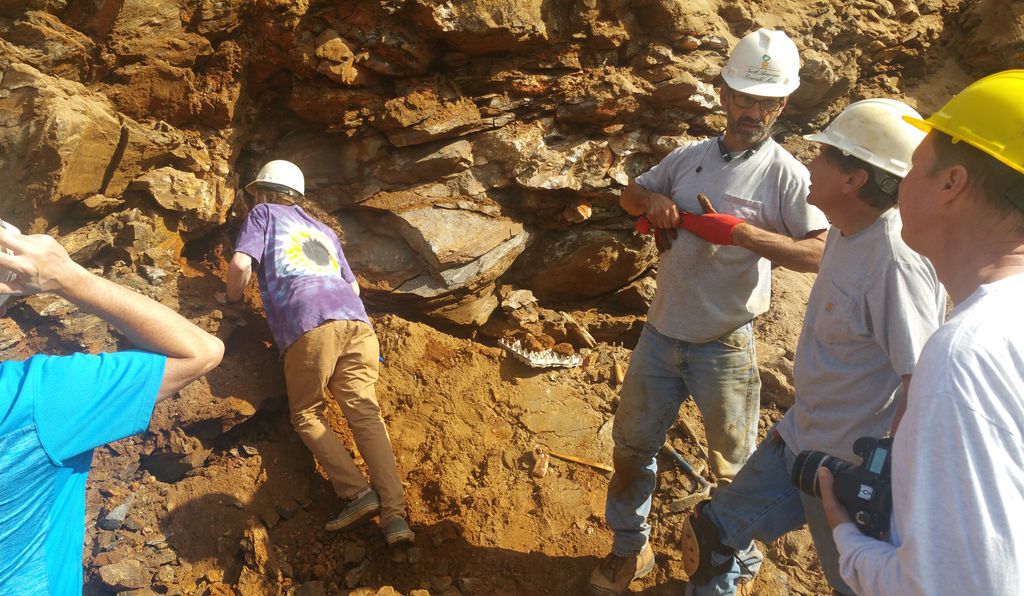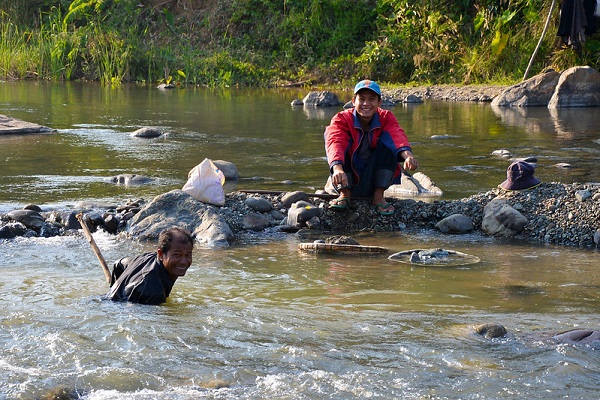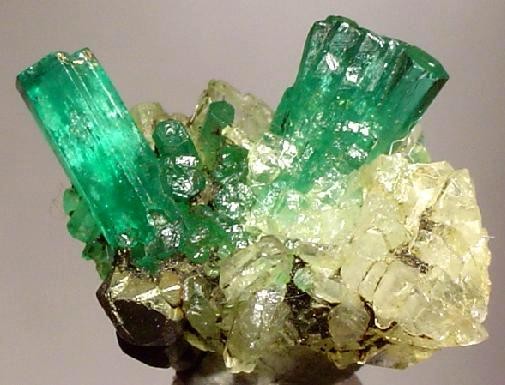Gemstone Geology FAQ
Gemstones are formed below the surface of earth inside the earth’s crust. They usually show traces of other minerals, called inclusions.
We find gemstones in a lot of different environments. They are divided into two main categories: Primary Deposits and Secondary Deposits.
Primary deposit yields the gemstone at the same place where it was formed. Usually, it is inside the host rock. The gem has formed and is growing in a rock, and you find it as is where it is. The rock in question could have been eroded by the elements. It might be crumbling, but it is still present on the spot. And the gemstone is still inside. But mostly, the rock has still not weathered and hard. Evidently, mining the gem requires hard labor.
Emerald Hollow Mine in Hiddenite, North Carolina, offers multiple gem hunting opportunities for visitors: digging, creeking and sluicing. (Courtesy of Emerald Hollow Mine)
Primary deposits do not hold dense clusters of the jewels. The concentration is low to medium. They are sprinkled across the interior body of the rock. Moreover, the quality is also mixed. The scattered rough is of different grades. You have the high quality gem material hobnobbing with cracked, included or off-colored stones. This is because the material has not moved from the keeper rock.
Mining here is difficult because you need a lot of energy to break the rock and pry out the gem-crystals. Also, you cannot do it on a large scale by using heavy machinery or explosives. That will shatter the gemstones along with the rocks. If at all explosives are to be used, they have to be used in a very controlled manner. This balancing act makes hard rock mining arduous to conduct.
But such efforts are inescapable for certain gemstones like emeralds which are invariably found in primary deposits. Pegmatites in Brazil are primary deposits for gems such as tourmaline and topaz. Metamorphic rocks in East Africa are primary deposits for tanzanite. The Mogok Stone Tract mines in north-central Burma is a primary deposit of rubies. Here, people mine the rubies directly from the marbles in a highly labor intensive process.
Though mining is difficult in primary deposits, it has an intrinsic advantage. You end up getting a good understanding of the local geology. You also comprehend the natural processes that form the gem. This is possible because you look at the gem forming rock bang on the spot. The opportunity to study geology and its artistry is huge.
We all know that nature is constantly sculpting and reshaping the land masses on earth. This happens through a process called erosion. Wind, water and heat of the sun carry out this erosion incessantly. Cycles of day time heat and night time cold induce expansion and contraction of rocks. Air or water or both are perpetually hitting the land masses. Consequently, even the hardest of rocks crack over the course of time.
Dredging for Gem Stones in Pailin Two miners dredging the river bottom in their search for rubies and sapphires near Pailin, Cambodia
The holding rock might disintegrate in the above manner, but the contained gems are much harder. As such they survive and are released in the open. These loosened gem crystals either roll downhill with gravity and wind, or they roll downstream with water. They are then found on foothills or on river beds as secondary deposits.
Secondary deposit mining has its own innate advantages. Firstly, you don’t need to work hard as the gems are already out of the rocks and yours to pick. Nevertheless, you need a lot of patience and time to literally sift through the sand. Secondly, the gems are already collected together by natural forces. As such, gems are concentrated in smaller regions.
Along with higher concentration of gems you get higher quality gemstones. This is because low quality rough with imperfections, cracks and fractures do not survive the rough and tumble of their long journey. Only the best specimens are able to endure and carry through. By this token, harder gems like corundum and spinels tend to be found in secondary deposits. In addition, secondary deposits also produce various varieties of Garnets.
On the flip side, you are neither able to understand the geology of the gem, nor the natural processes involved in forming the stone. This is owing to the fact that the region of formation is completely detached from the region of discovery.
A mineral satisfies the following five criterion:
1) It occurs naturally. These days, synthetic corundum or lab-grown diamonds are created artificially. The man-made material is exactly the same as the naturally occurring one. Yet, only naturally occurring ones are classified as minerals.
2) A mineral is not biogenic. This means that it is not organic in origin. For example: pearl and amber are considered as gemstones. But they are not minerals as they are organic in origin.
3) A mineral has an ordered internal structure. This means it has a predictable molecular structure that repeats ad infinitum. Opal is a gemstone. But it is not a mineral since it lacks this fixed structure.
4) A mineral has a precise and specific chemical composition which can be expressed as a molecular formula.
5) A mineral is solid at room temperature.
A mineral can be as simple as diamond at the molecular level. It is pure carbon with a fairly simple crystal lattice. Or you can have complex minerals like garnets.
A crystal is any solid with a well-ordered internal structure. It need not be naturally occurring and it can be organic. All minerals are crystals. But all crystals are not minerals.
You need the right chemical conditions.
1) Whether water is present or not?
2) pH level of the environment. Whether it is acidic or alkaline
3) What is the degree of oxygen present?
4) Whether the constituting elements are present and available.
By present and available we mean that constituting elements should not have already been used up for forming other compounds. They should be free to form our mineral.
In addition, right temperature and pressure conditions should exist. And then we need time. Eons of it.
We all know that the interior of earth is a far cry from the sterile environs of a lab. Nature cooks its stones in a dirty kitchen. Furthermore, the pressure and temperature conditions are seldom right.
Pure carbon transforms into diamonds under favorable temperature and pressure conditions. This happens over the course of millions of years .
The oxides and the hydroxides have a strong oxygen or hydroxyl group and create important gemstones. Aluminum oxide engenders corundum while magnesium aluminum oxide begets Spinels.
Plate tectonics is the violent interaction between the various tectonic plates constituting the earth’s crust.
Earth’s crust is a thin solid layer swimming on the surface of the mantle below. And the crust is not a continuous single piece. It is broken into massive irregular shaped pieces. These huge chunks of crust are termed as tectonic plates. They are of two types: continental plates and oceanic plates.
Slow convection currents are generated deep within the mantle due to radioactive heating. These currents drive lateral movements of the plates at a rate of several centimetres per year. As such, the plates bump and interact along their margins.
When converging continental and oceanic plates collide, the denser oceanic plate slides under the less dense continental plate in a process called subduction. This interaction is relatively less violent.
But when a converging continental plate collides with another continental plate, there is no subduction because of similar densities. The massive momentum creates monumental geological forces. The plates crumple and fold against one another. This creates immense pressure as well as heat – conditions conducive to gemstone/mineral formation. The rising folds of land create the mountains. And the gems are created inside the rocks.
Corundum is better known by the more popular names of Ruby or Sapphire. It is a crystal of aluminium oxide having formula Al2O3. Oftentimes, the mineral includes trace impurities of chromium, iron, vanadium and titanium. It is transparent in pure form. However, presence of aforesaid impurities impart color to it. Chromium traces impart the red color to ruby. Iron and Titanium impart blue to blue sapphire.
Chemical formula of Corundum Al2O3 looks fairly simple. Two parts Aluminum, three parts oxygen. Oxygen and Aluminum are both abundant in the crust. So it should not be difficult to form corundum.
But we know that corundum is very rare and hence it is a precious stone. What is the reason? It is because other compounds lock up all the available oxygen and aluminum. Silicon which is another plentiful element in the crust has a strong affinity for aluminum. It combines with aluminum to form silicates. That leaves little or no aluminum left for forming corundum.
So corundum is able to form only in the absence of free silica. Or if surplus aluminum is left behind after formation of silicates. This is able to happen in metamorphic rocks, marbles and magmatic rocks. And the corundum crystals have inclusions typical to the type of rock where it was found.
Also, a great deal of corundum is mined from secondary deposits where it is not possible to study the rocks and processes that lead to corundum formation.
We move on to another mineral which is beryl. And let us talk about emerald as it is the most well known form of beryl. Its chemical formula is Be₃Al₂SiO₆. We see that it is 3 parts beryllium, 2 parts aluminum, 1 part silicon and 6 parts oxygen. Trace quantities of chromium (or less frequently) vanadium impart the green color.
This aesthetic specimen from the CHIVOR MINE features two gemmy and lustrous, rabbit ears-like emerald crystals set on calcite matrix with a lustrous pyritohedron in front as a nice accent.
Silicon, Oxygen and aluminum occur in copious quantities in the crust. But beryllium is extraordinarily rare. It is only 0.00019% of earth’s crust. Then again, it is concentrated in certain pockets. This happens in rocks called pegmatites. They are igneous rocks, formed underground, with interlocking crystals. So we find a lot of Beryls in pegmatites.
But still you need chromium to give the green color. And chromium too is excessively rare. Moreover, it occurs in a different kind of habitat. You usually don’t find chromium where you find beryllium.
So extremely rare and complex environments where beryllium and chromium come together are needed to create emeralds. Which is why an emerald is such a special gemstone.
Many of the world’s emerald deposits form in areas of contact metamorphism. That is to say when a chromium bearing rock comes in contact with a beryllium bearing rock.
You have a Schist or gneiss rock. These are metamorphic rock bearing chromium or vanadium. And you have a pegmatite rock which is a source of beryllium intruding into the former. When these two types of rocks come in close proximity, emerald forms in the gneiss or the schist or on the margins of the pegmatite.
Chemical formula for corundum is Al2O3 while that of Beryl is Be₃Al₂SiO₆. Chromium is present as trace impurity in both types of molecules. Crystal lattice structure of both molecules is different. As such, the chromium atom is surrounded by different types of atoms and in different positions in corundum and beryl.
The permutations and combinations lead to different inter-play with incident light. Different spectrum are absorbed and different spectrum are reflected upon the eyes from both. Consequently, the eye sees red in corundum and green in beryl.
Chromium causes the color change perceived in gemstone alexandrite. It is the same coloring element that causes the red of ruby and the green of emerald.
Light from an incandescent source is flush with red or blue wavelengths. On the other hand, light from the sun is richer in green wavelength. The typical molecular structure of Alexandrite causes different interplay of incident wavelengths with chromium inside the gem. Therefore, the eye sees this gem in different colors in different sources of light.
A natural corundum forms over the course of millions of years. All the chemical processes and changes occur very slowly and gradually. Furthermore, we know that mother nature cooks in a dirty kitchen with unneeded impurities. All this leaves behind chemical traces that have been analyzed and are known to gemologists.
The same chemical processes and changes occur almost instantaneously in case of man-made corundum. Also, a lab has a clean, sterile and controlled environment as opposed to open nature. This leaves behind a completely different type of chemical signature. Again these have been analyzed and are known to gemologists.
That is how gemologists are able to make out if a corundum is natural or man-made.


